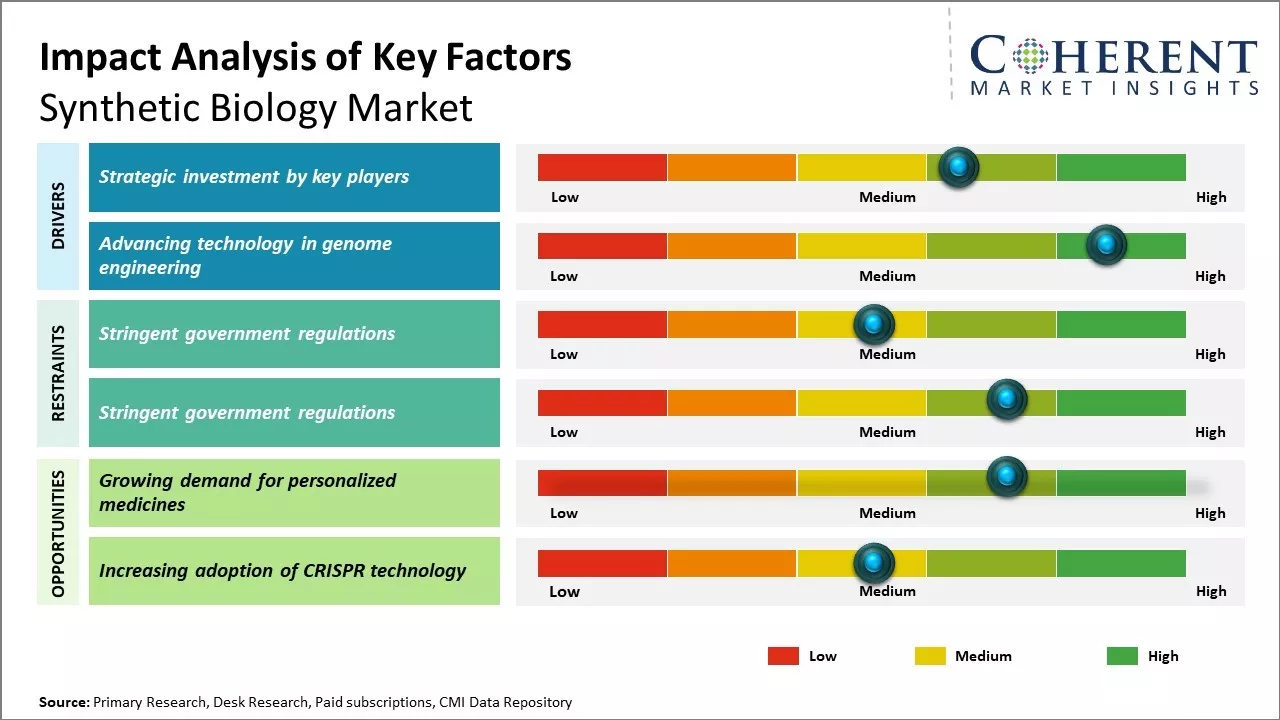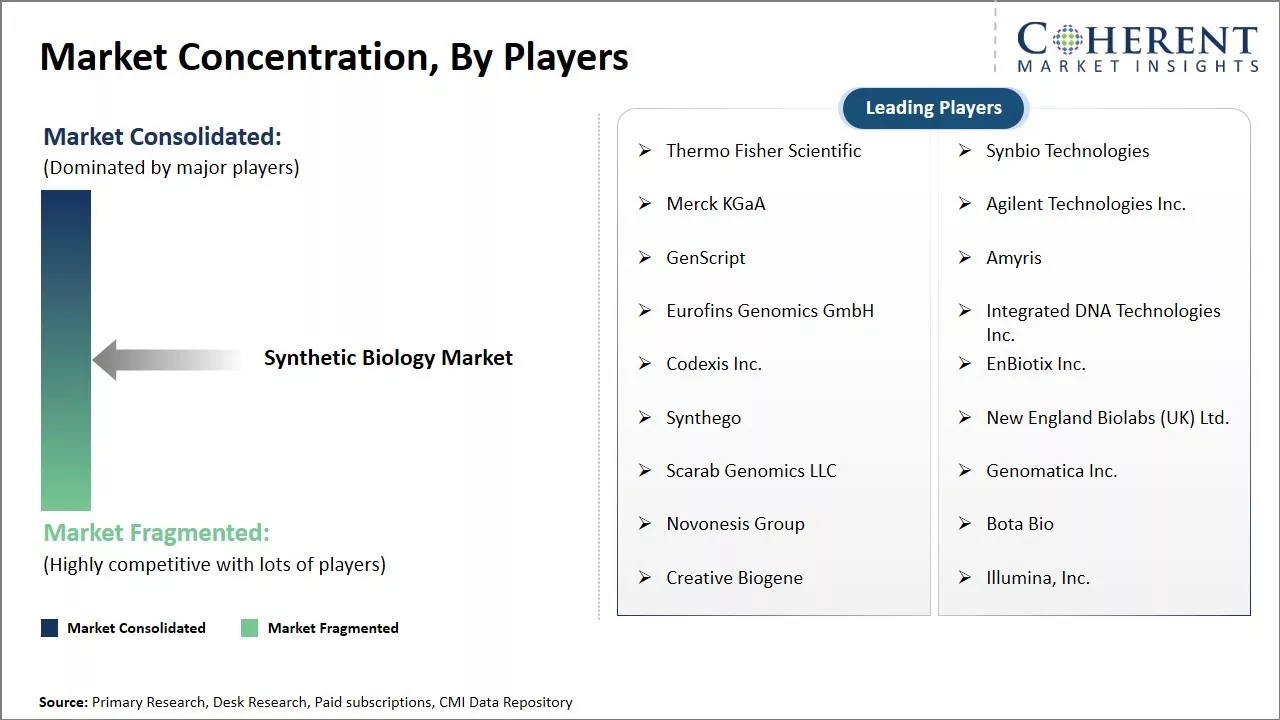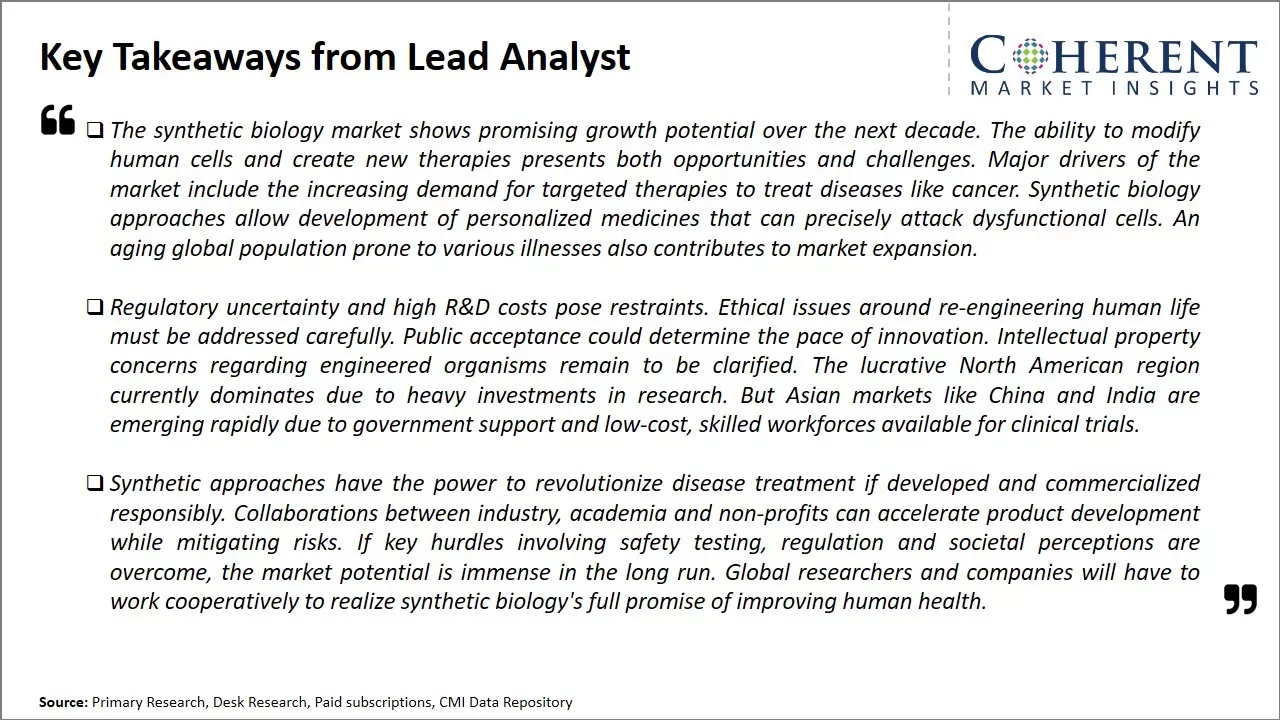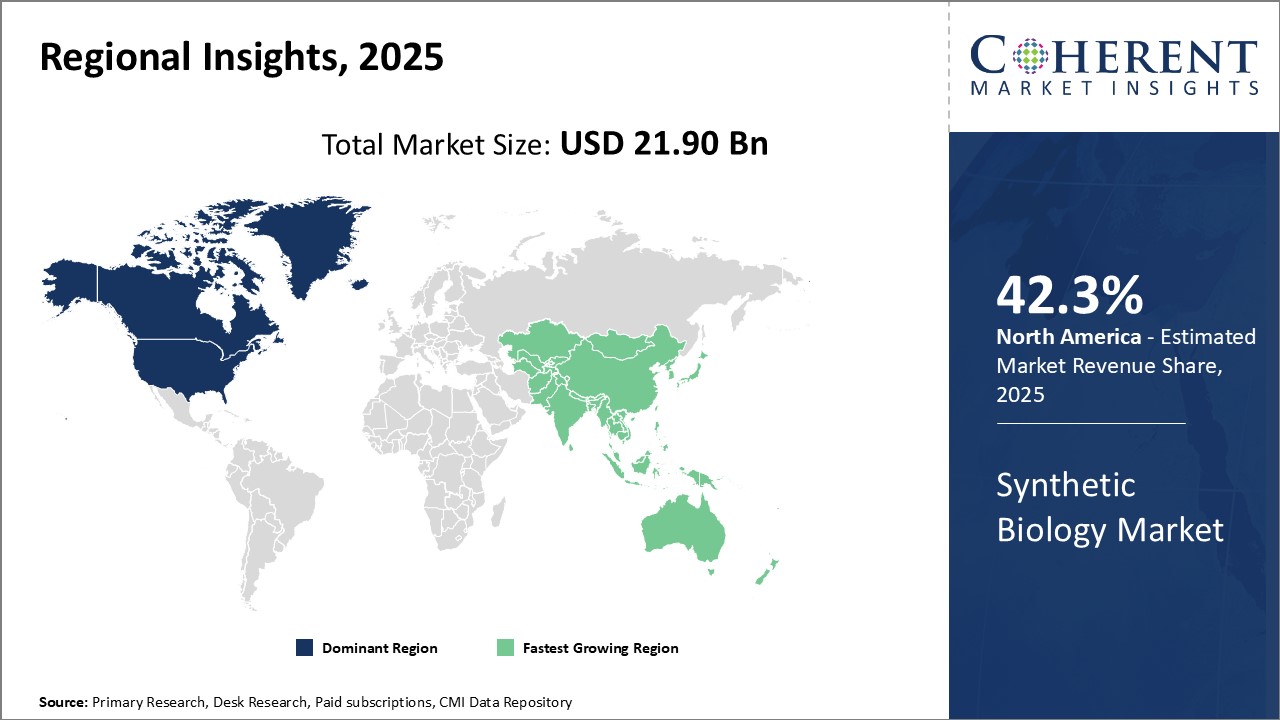The synthetic biology market is estimated to be valued at USD 21.90 Bn in 2025 and is expected to reach USD 90.73 Bn by 2032, growing at a compound annual growth rate (CAGR) of 22.5% from 2025 to 2032.

Discover market dynamics shaping the industry: Request sample copy
The synthetic biology market is expected to witness significant growth over the forecast period. Advancements in DNA sequencing and gene-editing technologies are expanding the applications of synthetic biology in various healthcare verticals. Continuous research activities in synthetic DNA/RNA development for drug discovery and genome engineering is positively impacting the market growth. Adoption of synthetic approaches to design advanced biomaterials, medical devices, and biomolecules is gaining traction. Furthermore, rising R&D investments by biopharmaceutical companies and academic research institutions in the synthetic biology domain will propel the synthetic biology market during the projected timeframe.
Strategic investment by key players
Changes in public awareness of synthetic biology lead to an increase in the demand for synthetic biology products. Thus, key players in the market are engaged in investing in strategic development such as acquisition, collaboration, etc. in order to expand their business and address the demand. For instance, in November 2020, Codexis, Inc., a leading synthetic biology company in collaboration with a leading life science investor, Casdin Capital, announced the launch of SynBio Innovation Accelerator. Sumitomo Chemical is one of the leading players in Japan, and it launched SynBio Hub, a new organization in the U.S. to accelerate next-generation business utilizing synthetic biology.

Get actionable strategies to beat competition: Request sample copy
Advancing Technology in Genome EngineeringWith the advent of new breakthrough technologies like Clustered regularly interspaced short palindromic repeats (CRISPR), synthetic biology is poised to revolutionize how healthcare issues are addressed. Techniques like CRISPR allow researchers to easily edit genes and regulate the expression of genetic material with unprecedented precision. This has enormous potential to treat many diseases that were previously incurable. Conditions like sickle cell anemia, cystic fibrosis, and various types of cancer which have genetic origins could potentially be corrected at the DNA level. Companies are actively pursuing therapies using genome editing for clinical applications.
CRISPR also enables the synthesis of entirely new genetic codes that do not exist in nature. Scientists are learning to programme and assemble DNA the way computers are programmed. This will allow engineering cells and biological systems with customized functions. Researchers have synthesized bacterial genomes from scratch as a proof of concept and more complex genomes will be achieved. Such advanced forms of genome engineering will drive the synthetic biology market as it opens up new paradigms for diagnosing, preventing and curing diseases. Pharmaceutical firms are investing heavily in genome editing research to develop genetically targeted treatments. As the technology matures, it will make personalized medicine a reality by allowing genetic corrections to be made for each individual's unique genetic profile.

To learn more about this report, Request sample copy
Market Challenges: Stringent government regulationsThe synthetic biology market faces several challenges in the coming years. Regulatory hurdles around the safety and ethical use of synthetic organisms pose compliance difficulties. Additionally, high R&D costs associated with developing new synthetic products and the long timeline to market impact return on investment potential. Synthesizing complex biological pathways and programming cells requires advanced research that is technically challenging. Public perception of synthetic cells being "unnatural" could generate reluctance towards adoption.
Market Opportunities: Growing demand for personalized medicines
The ability to program cells to target specific diseases opens possibilities for advanced diagnostics and personalized treatments. Synthetic biology tools allow engineering cells for regenerative medicine and 3D printing living tissues. Production of therapeutic proteins, antibodies, and vaccines through cellular engineering rather than livestock/crop cultivation promises sustainability. Lowering drug development costs through the precision of synthetic engineering attracts pharmaceutical investment.

Discover high revenue pocket segments and roadmap to it: Request sample copy
Insights, By Product: The Rise of Precision Medicine Drives the Growth of OligonucleotidesThe product segment includes oligonucleotides, enzymes, synthetic cells, chassis organism, and others. Oligonucleotides is anticipated to hold 28.3% of the market share in 2025. Oligonucleotides are short strands of synthetic nucleic acids that can be modified to target specific genes. Their high specificity makes them a valuable tool for treating conditions at the genetic level. As our understanding of genomics advances, more drug developers are utilizing oligonucleotides to combat diseases. Their programmable nature allows designing therapies that interfere with or modify target mRNA and regulate gene expression. Areas like oncology have seen promising results with oligonucleotide drugs that can block proteins driving cancer progression. Their ability to impact single genes with precision makes them well-suited for an era focused on personalized healthcare. More drug makers are incorporating oligonucleotides into pipelines as the benefits of tailored treatments for rare diseases and various cancers become clear. Their usage is poised to expand further as genomic research uncovers new targets and delivery methods to optimize oligonucleotide potency continue evolving.
Insights, By Technology: Rise in Research and Development Activities Drives the PCR growth
The technology segment includes genome engineering, PCR technology, bioprocessing technology, NGS technology, bioinformatics, nanotechnology, and others. The PCR technology segment is expected to hold 26.1% of the market share in 2024. The polymerase chain reaction (PCR) technique is a cornerstone of modern biotechnology that amplifies snippets of DNA across billions of copies. It allows detecting rare gene variants and pathogens, validating transgenic organisms, and quantifying genetic material. Since its introduction in the 1980s, continuous improvements have made PCR more sensitive and high-throughput. Its ability to rapidly make millions of copies of specific DNA sequences in an automated process accelerates research goals. Academia and industry rely on PCR for tasks like validating recombinant DNA constructs, screening cell lines, and underpinning diagnostic tests. As understanding of genomics and personalized medicine grows, PCR fuels discovery by facilitating analysis of genetic sequences. Its versatility and high reproducibility have cemented its role in basic research as well as application areas such as forensics. Advancements like quantitative PCR and droplet digital PCR further multiplier PCR’s utility.
Insights, By End User: Innovation in Therapeutic Development Drives the Growth of Biotechnology Companies
The end user segment includes pharmaceutical companies, biotechnology companies, CMO & CRO, and others. Biotechnology companies contribute the highest share of the synthetic biology market and is projected to hold 34.1% of the market share in 2025. Biotech firms play a pivotal role in leveraging the latest tools from synthetic biology and associated fields to develop innovative therapeutics. They house dedicated R&D divisions exploring how techniques such as oligonucleotide engineering, gene editing and cellular reprogramming can combat disease. Many biotechs have pipelines centered on harnessing these technologies, whether developing new gene or cell therapies or engineering microbes to produce pharmaceutical ingredients. Compared to large pharmaceutical corporations, biotechs have more flexibility pursuing high-risk ventures with potential for step-change results. Successful examples include utilizing CRISPR for developing crops resistant to herbicides as well as engineering immune cells to treat cancer. The innovative nature of synthetic biology lends itself well to biotech’s ability to pivot rapidly between research areas. As healthcare increasingly relies on customized solutions, biotech firms’ focus on applying emerging platforms serves as a key driver for continued synthetic biology adoption in drug discovery.

Need a Different Region or Segment? Customize now
North America has emerged as the dominant region in the global synthetic biology market, mainly driven by heavy investments in research and development by leading biotechnology companies based in the U.S. and Canada. North America is expected to hold 42.3% of the market share in 2025. The region is home to global leaders in synthetic biology technologies which are focusing on developing advanced gene and cell therapies using cutting edge tools of synthetic biology. Presence of major academic research centers and government funding for synthetic biology research through initiatives like NIH has propelled innovations and translational research in the region.
Asia Pacific region, on the other hand, represents the fastest growing market globally. Rapidly developing economies like China and India are providing conducive environments for growth of biotechnology sector. Considerable funds are being invested by both public and private players to develop local synthetic biology capabilities. China, in particular has shown focused and coordinated efforts to emerge as a leader in synthetic biology through initiatives like GIDL projects. Additionally, cost competitiveness for manufacturing and presence of highly skilled scientific workforce are attracting global companies to establish manufacturing facilities and R&D centers in the region. Countries in Asia Pacific are also increasingly focusing on healthcare needs of their rising populations by funding development of new biologic drugs and therapies. This makes synthetic biology an attractive avenue for growth. Reduced regulatory barriers compared to developed markets also provide early market access for locally developed synthetic biology products. Growing demand for healthcare and biopharmaceuticals will continue driving the synthetic biology market across Asia Pacific in the coming years.
Synthetic Biology Market Report Coverage
| Report Coverage | Details | ||
|---|---|---|---|
| Base Year: | 2024 | Market Size in 2025: | USD 21.90 Bn |
| Historical Data for: | 2020 To 2024 | Forecast Period: | 2025 To 2032 |
| Forecast Period 2025 to 2032 CAGR: | 22.5% | 2032 Value Projection: | USD 90.73 Bn |
| Geographies covered: |
|
||
| Segments covered: |
|
||
| Companies covered: |
Thermo Fisher Scientific, Synbio Technologies, Merck KGaA, Agilent Technologies Inc., GenScript, Amyris, Eurofins Genomics GmbH, Integrated DNA Technologies Inc., Codexis Inc., EnBiotix Inc., Synthego, New England Biolabs (UK) Ltd., Scarab Genomics LLC , Genomatica Inc., Novonesis Group, Bota Bio, Creative Biogene, and Illumina, Inc. |
||
| Growth Drivers: |
|
||
| Restraints & Challenges: |
|
||
Uncover macros and micros vetted on 75+ parameters: Get instant access to report
Share
Share
About Author
Abhijeet Kale is a results-driven management consultant with five years of specialized experience in the biotech and clinical diagnostics sectors. With a strong background in scientific research and business strategy, Abhijeet helps organizations identify potential revenue pockets, and in turn helping clients with market entry strategies. He assists clients in developing robust strategies for navigating FDA and EMA requirements.
Missing comfort of reading report in your local language? Find your preferred language :
Transform your Strategy with Exclusive Trending Reports :
Frequently Asked Questions
Joining thousands of companies around the world committed to making the Excellent Business Solutions.
View All Our Clients
US Reciprocal Tax Impact Analysis On Synthetic Biology Market
Stay updated on tariff changes with expert insights and timely information